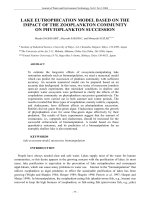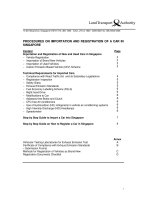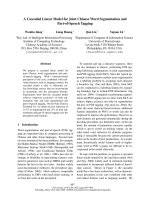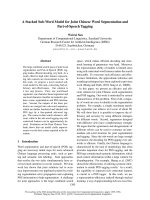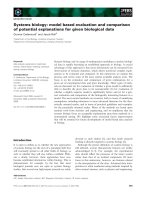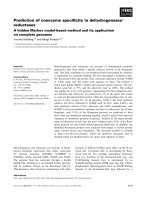Model based segmentation and registration of multimodal medical images
Bạn đang xem bản rút gọn của tài liệu. Xem và tải ngay bản đầy đủ của tài liệu tại đây (2.32 MB, 144 trang )
i
Model-Based Segmentation and
Registration of Multimodal Medical Images
ZHANG JING
(B.Eng. Tsinghua University, M.Eng. NUS)
A THESIS SUBMITTED FOR THE DEGREE OF DOCTOR OF
PHILOSOPHY
DEPARTMENT OF ELECTRICAL & COMPUTER ENGINEERING
NATIONAL UNIVERSITY OF SINGAPORE
2009
ii
Acknowledgements
First and foremost, I wish to express my sincere appreciation to my supervisors,
A/Prof Ong Sim Heng and Dr. Yan Chye Hwang. Their motivation, guidance and
instruction are deeply appreciated. I would like to thank them for giving me the
opportunity to pursue my interest in research.
I also want to thank Dr. Chui Chee Kong for his patience, encouragement and
tremendous help offered. I am grateful for his trust and belief in me.
I am thankful to Prof. Teoh Swee Hin for his advice and assistance.
I thank all the staff and research scholars of Biosignal Lab who have been a terrific
bunch to work with. These individuals are: Wang Zhen Lan, Jeremy Teo and Lei
Yang.
Last but not least, I would like to thank my family for all their support and
encouragement.
iii
Table of Contents
Summary vi
1 Introduction 1
1.1 Motivation 1
1.2 Background 2
1.2.1 CT and MRI 2
1.2.2 Image-guided Therapies for Vertebral Disease 5
1.3 Proposed Medical Image Processing System 6
1.4 Thesis Contributions 8
1.4.1 3D Adaptive Thresholding Segmentation 8
1.4.2 3D CT/CT Surface-based Registration 8
1.4.3 MR Image Segmentation and CT/MR Image Registration 8
1.4.4 Statistical Modeling of Vertebrae 9
1.5 Thesis Organization 9
2 Literature Review 12
2.1 Image-guided Surgery 12
2.1.1 Simulation and Planning 12
2.1.2 Validation 14
2.2 Medical Image Segmentation 15
2.2.1 Region-based techniques 16
2.2.2 Surface-based techniques 18
2.3 Medical Image Registration 18
2.3.1 Landmark-based Registration 19
2.3.2 Voxel Property-based Registration 20
2.3.3 Registration Based on Image Segmentation 20
2.3.4 CT Bone Registration 23
2.4 Statistical-based Modeling 25
3 Segmentation Error! Bookmark not defined.
3.1 Introduction 27
iv
3.2 Method 27
3.2.1 Initial Segmentation 33
3.2.2 Iterative Adaptive Thresholding Algorithm 34
3.2.3 3D Adaptive Thresholding 35
3.3 Experiments 37
3.3.1 Dataset 37
3.3.2 Experimental Design 37
3.4 Results and Discussion 43
3.5 Conclusion 47
4 Surface Based Registration 49
4.1 Overview of Registration System 49
4.2 Methods 51
4.2.1 CT Image Segmentation 51
4.2.2 Coarse Registration and Neural-Network-based Registration 51
4.3 Experiments 58
4.3.1 Datasets 58
4.3.2 Experiment Design 59
4.4 Results and Discussion 63
4.5 Conclusion 67
5 Iterative Weighted CT/MR Image Registration 68
5.1 Introduction 68
5.2 Methods 70
5.2.1 Iterative Segmentation/Registration System 70
5.2.2 MR Image Segmentation 70
5.2.3 Weighted Surface Registration 75
5.2.4 Iterative Segmentation/Registration 76
5.3 Experiments 77
5.3.1 Dataset 77
5.3.2 Experimental Design 79
5.4 Results and Discussion 83
5.5 Conclusion 91
6 Statistical Modeling of Vertebrae 93
v
6.1 Introduction 93
6.2 Methods 94
6.3 Statistical Model Based Deformation Results 99
6.4 Conclusion 103
7 Conclusion and Future Work 104
7.1 Conclusion 104
7.2 Image-based Bone Material Estimation 106
7.3 Clinical Applications 107
Bibliography Error! Bookmark not defined.
Appendix A 124
Appendix B 127
vi
Summary
Registration helps the surgeon to help overcome the limitation of relying on a single
modality for image-guided surgery. There is a need for an accurate registration system
which will improve surgical outcomes. The work described has involved the
investigation and development of a new registration system based on computational
model. Preoperative CT images of patient are segmented using an adaptive
thresholding method, which takes into consideration the inhomogeneity of bone
structure. A patient-specific surface model is then constructed and used in the
registration process.
We proposed and developed a new automatic surface-based rigid registration system
using neural network techniques for CT/CT and CT/MRI registration. A multilayer
perceptron (MLP) neural network is used to construct the bone surface model. A
surface representation function has been derived from the resultant neural network
model, and then adopted for intra-operative registration. An optimization process is
used to search for optimal transformation parameters together with the neural network
model. In CT/CT registration, since no point correspondence is required in our neural
network (NN) based model, the intra-operative registration process is significantly
faster than standard techniques.
We proposed a weighted registration method for CT/MRI registration, which can
solve the CT/MR registration problem and MR image segmentation problem
vii
simultaneously. This approach enables fast and accurate CT/MR feature based
registration, accurate extraction of bone surface from MR images, and fast fusion of
the two different modalities. Since the bone surface in CT images can be extracted
quickly and accurately, the CT segmentation result is used as the reference for MR
image segmentation. The process starts with a coarse extraction of bone surface from
MR images, and the coarse surface is then registered to the accurate bone surface
extracted from CT images. The CT bone surface is re-sampled according to the
registration result. It is used as the initial estimation for MR image segmentation. The
MR segmentation result is subsequently registered to CT bone surface. The
segmentation result of MR images is improved at each iterative step using the CT
segmentation result. In the iterative segmentation-registration process, since the goal
boundary is close to the initial one, only fine adjustment is needed. Computational
time is hence saved and unreasonable segmentation due to poor scans can be
effectively avoided.
We also investigated the application of statistical methods to assist CT/CT and
CT/MR registrations. CT/CT and CT/MRI registration methods were integrated into a
generic software toolkit. The toolkit has been used in segmentation of various human
and animal images. It has also been applied to register human bone structures for
image-guided surgery. The successful completion of the weighted registration method
greatly enhances the state-of-art for CT/MRI registration.
viii
List of Tables
Table 3.1. Segmentation accuracy measurements. 43
Table 3.2. Processing time. 47
Table 4.1. Surface modeling results. 63
Table 4.2. Calcaneus comparison results with frame-based registration (reference
dataset is CA). 66
Table 4.3. Full surface registration accuracy results and execution time of spine
datasets (reference dataset is SA, V1 is the first vertebra and V2 the second
vertebra). 66
Table 5.1. Datasets used in the experiments. 79
Table 5.2. Dataset specifications. 81
Table 5.3. Registration/Segmentation time. 85
Table 5.4. Average cost after converging. 89
Table 5.5. Execution time and volumetric overlap results. 90
ix
List of Figures
Figure 1.1. Basic scanning system of computed tomography (adapted from [1]). 3
Figure 1.2. MRI scanner (adapted from [2]). 5
Figure 1.3. Flowchart of feedback segmentation-registration system. 7
Figure 2.1. Examples of 2D transformations (adapted from [24]). 22
Figure 3.1. Spine structure. (a) A typical spine specimen. (b) Enlarged view of the
vertebral body. 29
Figure 3.2. (a) CT image of spine. (b) Image produced by low threshold. (c) Image
produced by high threshold. (d) Image produced by using our adaptive
thresholding scheme 31
Figure 3.3. Illustration of segmentation procedure. (a) The pixels inside the white box
are used to estimate the mean
f
and the standard deviation
f
of soft tissue. (b)
Image produced by thresholding the CT image with a threshold of
.2
ff
(c)
Non-bone region extracted by floodfilling the thresholded image: the result of
initial segmentation. (d) Bone region after iterative adaptive thresholding. 32
Figure 3.4. 3D neighborhood definitions. 36
Figure 3.5. 3D window definitions. 36
Figure 3.6. Implementation procedure. 39
Figure 3.7. Original initial thresholded images. (a) Nth slice. (b) (N+1)th slice. 40
Figure 3.8. 2D adaptive thresholding result of Nth slice using automatic seed selection
at the top left corner of image. (a) Initial contour, Nth slice, automatic seed
selection. (b) Final result, Nth slice. 40
Figure 3.9. 2D adaptive thresholding result of Nth slice using manual seed selection. (a)
Initial contour, Nth slice, manual seed selection. (b) Final result, Nth slice. 41
x
Figure 3.10. 3D adaptive thresholding result of Nth slice. (a) Initial contour, Nth slice.
(b) Initial contour, (N+1)th slice. (c) 1st iteration, Nth slice. (d)1st iteration,
(N+1)th slice. (e) Final result, Nth slice. (f) Final result, (N+1)th slice. 42
Figure 3.11.Calcaneus segmentation results. (a)-(c) An overlay of the detected surface
results at different locations of calcaneus. (d) Reconstructed 3D image based on
segmentation results. 44
Figure 3.12. Spine segmentation results, dataset 1. (a)-(c) An overlay of the detected
surface results at different locations of spine. (d) Reconstructed 3D image based
on segmentation results. 45
Figure 3.13. Spine segmentation results, dataset 2. (a)-(c) An overlay of the detected
surface results at different locations of spine. (d) Reconstructed 3D image based
on segmentation results. 46
Figure 3.14. Red line highlights the narrow gaps that were not detected. 48
Figure 4.1. A registration system for image-guided surgery. 49
Figure 4.2. Segmentation results. (a) Original CT image. (b) Bone region after iterative
adaptive thresholding. 50
Figure 4.3. Network structure for surface function approximation.
i
denotes the
number of nodes in the first hidden layer;
j
denotes the number of nodes in the
second hidden layer 56
Figure 4.4. Original images from different spine datasets. (a) 38th slice of SA. (b) 38th
slice of SB. 60
Figure 4.5. Original images from different calcaneus datasets. (a) 90th slice of CA. (b)
90th slice of CB. 60
Figure 4.6. Surface modeling results. (a) CA (c) SA-V1 (e) SB-V1: Extracted surface.
(b) CA (d) SA-V1 (f) SB-V1: NN surface model. 61
Figure 4.7. Registration error map of one slice from SB in registering SB to SA using
V1. 65
Figure 5.1. Flowchart of feedback segmentation-registration. 71
Figure 5.2. Flowchart of iterative segmentation/registration. 78
xi
Figure 5.3. Experimental datasets: (a) HS1_MR, (b) HS2_MR, (c) HA_MR 82
Figure 5.4. Experiment segmentation/registration results of dataset HA_MR: 86
Figure 5.5. Converged registration results: (a) dataset HS1_MR, (b) dataset PS1_MR.
87
Figure 5.6. (a) Axial, sagittal and coronal views of the fused CT/MR hybrid model of
a patient with cracked vertebrae. (b) Axial view of the fused CT/MR hybrid
model of a patient with curved spine. 88
Figure 6.1. Detailed lateral (side) view of three lumbar vertebrae (adapted from [100]).
93
Figure 6.2. System structure. 95
Figure 6.3. CG firing searching. 97
Figure 6.4. Control points marked by center firing method. 101
Figure 6.5. Deformed shape by changing the shape parameter. Varying (a) first shape
parameter
1
α
, (b) second shape parameter
2
α
, (c) third shape parameter
3
α
101
Figure 6.6. Deformation results of different elastic modulus. (a) Target image. Results
of (b) small elastic modulus, (c) large elastic modulus, (d) optimal elastic modulus.
102
Figure 6.7. Patient specific finite element model. Left, central and right column are the
top, side and perspective view of the target vertebrae geometry, template mesh and
the transformed mesh, respectively. 102
Figure A.1. Class conditional probability density function. 10124
xii
List of Abbreviations
2D two dimensions
3D three dimensions
BMD Bone Mineral Density
CT computed tomography
DFLS double-front level set
DFT discrete Fourier transform
DXA Dual-Energy X-Ray Absorptiometry
FE finite element
FPGA field-programmable gate array
GD-DTPA gadolinium- Diethylene triamine pentaacetic acid
HD Hausdorff distance
ICP iterative closest point
MI mutual information
MLP multilayer perceptron
MR Magnetic resonance
MRI Magnetic resonance imaging
NMI normalized mutual information
NMR nuclear magnetic resonance
NMRI nuclear magnetic resonance imaging
NN neural network
xiii
PCA principal component analysis
QCT quantitative computed tomography
QUS quantitative ultrasound
RF radio-frequency
SNR signal to noise ratio
VHD Visible Human Dataset
VOI volume of interest
xiv
List of Notations and Variables
mean
standard deviation
B
bone
B
non-bone
x
pixel
)( xI
gray level of pixel
x
B
E
the set of boundary pixels in
B
)( xW
the window centered on pixel
x
r
radius
P
the surface point clouds of a dataset
Q
the surface point clouds of a dataset
p
a point of dataset
P
q
a point of dataset
Q
p
centroid of dataset
P
q
centroid of dataset
Q
P
a
N3
matrices
)(
N
pppP
Q
a
N3
matrices
)(
N
qqqQ
P
~
PPP
~
Q
~
QQQ
~
D
the distance between any two points
xv
R
a
33
rotation matrix
t
a 3D translation vector
T
a
N3
matrices
)(
N
tttT
U
Eigen matrix
V
Eigen matrix
Λ
Eigen matrix
)(TC
the cost of a transformation function
r
D
the reference surfaces
c
D
the current surfaces
r
f
reference surface function
),,( zyx
coordinates of a point
),,( zyxd
signed distance function
φ(·) activation function in neural network hidden layers
1
b
the biases for the first hidden layer
2
b
the biases for the second hidden layer
3
b
the biases for the output layer
R
the largest absolute eigenvalue of
)( RR
T
the largest absolute eigenvalue of
2
TT
B
the back-propagating level set
F
the forward-propagating level set
v
velocity field
threshold of gradient value
xvi
pre-defined small constant
S
DICE similarity coefficient
m
shape vector
ω
covariance matrix
k
eigenvalue
α
shape parameter
1
1 Introduction
1.1 Motivation
Many surgical procedures require highly precise localization, often of deeply buried
structures, in order for the surgeon to extract the targeted tissue with minimal
damage to nearby structures. Image-guided surgery is a solution to address this
clinical need. Segmentation and registration are important sub-tasks in image-guided
surgery. The region of interest is extracted in segmentation. Registration is the
process used to match the coordinate system of preoperative imagery with that of the
actual patient on the operating table. After registration, possible image-based
applications include interactive pre-operative viewing, determination of the incision
line and navigation during surgery.
Traditional clinical practice utilizes only 2D magnetic resonance (MR) or computed
tomography (CT) slices, and the surgeon must mentally construct the 3D object and
compare the critical image information to the body of the patient. CT provides
well-contrasted images of high-density biological objects such as bones and tumors
but is usually not preferred for detailed soft tissue examination. MR imaging, with
its moderate resolution and good signal-to-noise ratio is the modality of choice for
soft tissues. Fusing CT and MR images will help overcome the limitation of relying
on a single modality for image guided surgery. A typical fusion procedure comprises
segmentation of the CT and MR images, followed by registration and spatial
alignment/fusion. The region of interest in CT images (e.g., bone) or MR images
2
(e.g., kidney and liver) of a patient is first segmented. After spatial registration, the
segmented CT and MR images are aligned to give a model comprising
well-contrasted bone structure and the surrounding soft tissues. Such a composite
model is important for surgical planning and education. For example, a vertebra,
which is hard tissue, may have to be examined with the intervertebral disc, a soft
tissue, for effective spinal surgery planning.
The objective of this work was the development of a system to produce a
patient-specific hybrid model of the spine for image guided spinal surgery. The
system should comprise CT/MR image segmentation, CT/CT and CT/MR image
registration. It may also be employed for different anatomies, e.g., the ankle.
1.2 Background
1.2.1 CT and MRI
Quantitative Computed Tomography
In CT imaging, the two-dimensional internal structure of an object can be
reconstructed from a series of one-dimensional projections of the object acquired at
different angles as outlined in Figure 1.1.
The scanning for angles ranging from 0° to 360° is repeated so that sufficient data is
collected to reconstruct the image with high spatial resolution. The reconstructed
image is displayed as a two-dimensional matrix, with each pixel representing the CT
number of the tissue at that spatial location. As the CT number and the attenuation
3
coefficient of a voxel related to the bone is a near-linear function of the bone density,
CT imaging can be used to provide in-vivo quantitative analysis of bone density.
Figure 1.1. Principles of computed tomography image generation (adapted from [1]).
Magnetic Resonance Imaging
Magnetic resonance imaging (MRI) is an imaging technique used primarily in
medical settings to produce high quality images of the inside of the human body.
MRI is based on the principles of nuclear magnetic resonance, a spectroscopic
technique used by scientists to obtain microscopic chemical and physical
information about molecules. The technique was called magnetic resonance imaging
rather than nuclear magnetic resonance imaging (NMRI) because of the negative
connotations associated with the word nuclear in the late 1970's.
In MR imaging, in order to selectively image different voxels (volume picture
elements) of the subject, orthogonal magnetic gradients are applied. Although it is
relatively common to apply gradients in the principal axes of a patient (so that the
patient is imaged in
zyx and,
from head to toe), MRI allows completely
flexible orientations for images. All spatial encoding is obtained by applying
4
magnetic field gradients which encode position within the phase of the signal. In one
dimension, a linear phase with respect to position can be obtained by collecting data
in the presence of a magnetic field gradient. In three dimensions (3D), a plane can be
defined by "slice selection", in which an RF pulse of defined bandwidth is applied in
the presence of a magnetic field gradient in order to reduce spatial encoding to two
dimensions (2D). Spatial encoding can then be applied in 2D after slice selection, or
in 3D without slice selection. Spatially-encoded phases are recorded in a 2D or 3D
matrix; this data represents the spatial frequencies of the image object. Images can
be created from the matrix using the discrete Fourier transform (DFT). Typical
medical resolution is about 1 mm
3
, while research models can exceed 1 µm
3
. The
three systems described above form the major components of an MRI scanner
(Figure 1.2): a static magnetic field, an RF transmitter and receiver, and three
orthogonal, controllable magnetic gradients.
The MR method has been one of the most powerful tools in medical field as well as
in biological studies since the middle of last century. Magnetic resonance imaging is
attractive in that not only high-density objects (e.g. bones), but also the soft tissues
(e.g. brain, kidney) can be imaged with fair resolution and good signal to noise ratio
(SNR) [2]. More encouraging is the fact that magnetic resonance can be applied to
the live body safely in spite of the relatively high magnetic field.
5
Figure 1.2. MRI scanner (adapted from [3]).
1.2.2 Image-guided Therapies for Vertebral Disease
In spinal surgery, it would be helpful for the surgeons to have a panoramic view of
the vertebrae, the soft tissue, neural roots, and vessels around it. More care has to be
taken in pre-surgery planning to reduce the possibility of damage during the actual
operation. Thus there is a need to perform both CT and MRI scans on the patient.
Due to the nature of CT and MRI, they provide advantages over each other under
different circumstances. CT can give us well-contrasted images of high-density
objects such as bones and tumors. However, it works poorly if we intend to examine
soft tissue. MR images have the advantage under such circumstances in that both
soft tissue and bones are visible, though the resolution and contrast is not as good as
that of CT images. Thus these two modalities complement each other. After spatial
registration, the results can be used to construct a model comprising clear bone
structure and the surrounding soft tissues. This information can be used to plan the
surgical procedure by the surgeon. It can also be used for education or training.
6
1.3 Proposed Medical Image Processing System
The proposed and developed system comprises CT/MR image segmentation, CT/CT
and CT/MR image registration. As shown in Figure 1.3, segmentation is first
performed on CT images to separate the region of interest (bone) from its
surroundings. The bone surface is then used to construct the bone surface model
using a MLP neural network. An initial MR image segmentation captures the
general shape of the target object (the vertebrae). A coarse registration result is
obtained by registering the MR and CT surfaces with a weighted surface-based
registration algorithm. With the registered CT surface model as the reference, we
use the intermediate results of MR image segmentation and registration to iteratively
refine the suboptimal MR image segmentation. This iterative process is carried out
until the segmented CT and MR surfaces match within a specified tolerance. The
registered MR and CT dataset can be fused after this iterative process.
7
Figure 1.3. Flowchart of feedback segmentation-registration system.
8
1.4 Thesis Contributions
1.4.1 3D Adaptive Thresholding Segmentation
A novel 3D adaptive thresholding segmentation method is proposed for 3D CT
image segmentation. This fast and accurate method successfully segments the two
kinds of bone structures (vertebrae and ankle) in our experiments. In 3D adaptive
thresholding method, the thresholding of each voxel is updated up-to-date. For each
voxel, a local window, which is a cylindrical region, is defined. The respective
means and variances for bone and non-bone inside the corresponding region and
similarly are calculated and used to classify all the voxels. The entire volumetric
image is processed in an iterative process till it converges.
1.4.2 3D CT/CT Surface-based Registration
A novel automatic surface-based method using a neural network is used to perform
the registration. The neural network is used to construct an invariant descriptor for
human bone to speed up the registration process. Execution time and registration
accuracy are the two important specifications for a registration system. The
NN-based approach significantly improved computational.
1.4.3 MR Image Segmentation and CT/MR Image Registration
A new iterative methodology is proposed to perform fast and accurate multimodal
CT/MR registration and segmentation of MR dataset in a concurrent manner. In MR
image segmentation, we extend the ordinary single-front level set to the double-front
level set. This effectively reduces computational time by limiting the search area
around the target and enhances segmentation accuracy by avoiding leakage and
9
distraction by other objects. The iterative segmentation/registration method helps to
refine the segmentation of MR images and the registration of MR to CT. The
technique is fully automatic but still able to give results that are comparable to
manual segmentation.
1.4.4 Statistical Modeling of Vertebrae
A statistical model-based framework is proposed to rapidly create FE meshes with
patient-specific geometry using the CT images. These models can be used to create a
human spine FE meshes especially lumbar FE meshes. A center firing searching
method is implemented to find the correspondence control points for training the
statistical shape model. This method has two advantages over conventional
template-based mesh-generation methods. Firstly, a high mapping quality is ensured.
A proper vertebral template is selected using statistical analysis of a pre-trained
database instead of using a single template, which reduces the possibility of mapping
error for a complex structure such as vertebra. Secondly, minimum preprocessing,
e.g., pre-adjustment, is required.
1.5 Thesis Organization
This thesis brings together a 3D adaptive thresholding segmentation method in
Chapter 3, CT/CT surface-based registration in Chapter 4, weighted CT/MR
registration in Chapter 5 and statistical modeling of vertebrae in Chapter 6. These
methodologies enable us to produce hybrid CT/MR model and the possible
extension to spine structure.
